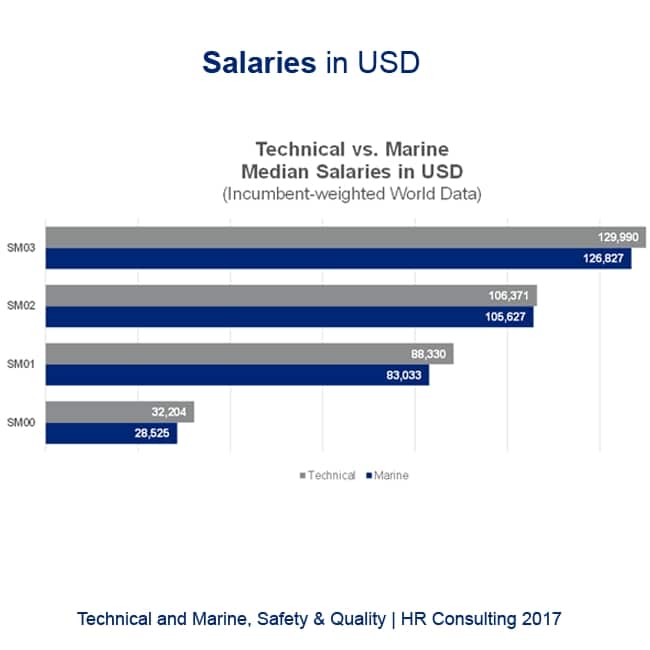Changing Course
Share this blog
Latest Maritime Vacancies
Global HR Director – Europe
Claims & Insurance Manager (Part-time) – London
Legal Counsel (Marine Operations) – London
Insurance Executive – Singapore
Operational and Commercial Pricing Analyst- London
Technical, marine, safety and quality salary insight

The popular Maritime HR Association ‘Market Analysis’ reports are being published to members and I’m delighted to be able to share a high level overview with you on some of our findings. This blog focuses specifically on our ‘Technical and Marine, Safety and Quality’ job family – which covers staff who are responsible for the running of the fleet.
Demographics, staffing structures and ratios
• An average of 47 technical and marine staff were reported per company in 2016.
• Overall, demand continues to be higher in the industry for technical staff – only within the LNG sector is there a greater demand for marine over technical staff.
• The job family is at least 81% male (see right: breakdown of incumbents by gender). Women are more likely to be found in marine specific roles, and almost three quarters of them can be found at the most junior level.
Base Salaries
• On a global basis, the industry still spends more on base salaries for technical staff than for marine staff, although over the years, the gap has narrowed and now remains small. See right – Technical vs. Marine median salaries in USD.
• The USA is the most consistently high payer across all levels of seniority.
• At entry level, salaries in the LNG industry are higher than other sectors, but this difference is not apparent as seniority increases. We suspect the high seagoing salaries in LNG may be dictating the need to pay higher entry level salaries to attract seafarers ashore.
• Overall, we find that those in the tanker industry are the most well-paid and staff responsible for offshore support vessels are generally the lowest paid.
Bonuses
• Technical salaries may be higher than marine salaries, but in 2016 we found the reverse was true when it came to bonuses. Higher technical salaries contrasted with higher marine bonuses resulted in more or less equivalent levels of total compensation across all levels of seniority in 2016.
• The USA held on to the top spot for bonus payments in 2016 whereas the UAE was near the bottom, with many in the region failing to receive a bonus.
• Those responsible for tankers received consistently high bonuses across all levels of seniority, but LNG staff fared best at the most junior levels. Dry Bulk bonuses lagged behind the rest of the market apart from at the most senior levels.
• Shipowners continued to pay higher bonuses than shipmanagers at the junior levels, but at manager level and above shipmanagers took the lead.
The full report naturally delves into more detail; Maritime HR Association members should have received a copy already and had the opportunity to join a webinar on the topic. New members can request a copy upon joining. Feel free to get in touch for more information.
Sarah Hutley, Compensation & Benefits Consultant, HR Consulting, Spinnaker Global